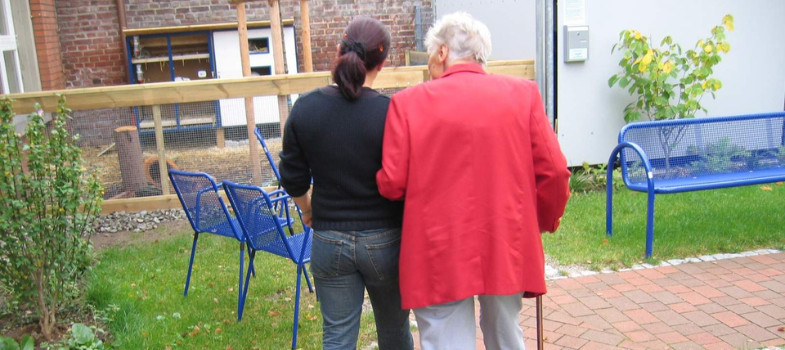2.3 Helping to manage slow movements (bradykinesia)
It might be hard for a person with Parkinson’s to move as quickly as they want to, which can be frustrating for them. Their ability to move might change very quickly, so at times they can move well, but within minutes they might slow down or stop. It’s important to remember that people are not being difficult when this happens.
People with Parkinson’s are sometimes referred to as having a shuffling gait. This is when a person doesn’t walk with a smooth motion and it may look like their feet are sticking to the floor.
Transcript
Let's take a look at this gentleman as he gets up out of his chair and walks around the room.
To be able to get out of his chair, he has to shuffle forward and start to press down on his hands to be able to gain the momentum to stand upright.
He's a little unsteady on his feet, so he does reach out for his walker to aid with his balance.
Now let's have a look at this walking.
As you can see, his stride length is quite good, and he is quite steady.
He's been asked now to turn a corner, and as you can see, he lifts his walker up, turns his upper body first, and then moves his legs and feet into the same direction.
As he walks across the room, you can see he's not quite picking his feet up.
His fronts of his feet are sliding along the floor and really, it's more of a shuffling step, than a full stride, that you and I would have.
Now he's going to walk independently.
Initially, he loses his balance, but can you see how much smaller his stride length is when he's walking independently?
He's not as confident or comfortable walking without his aid.
You can download this resource and view it offline. It may be useful as part of a group activity.
Actions to take
- Give the person plenty of time, support and patience.
- Keep in mind that they may have trouble getting up from a chair or find it hard to turn over in bed. They might also lack coordination in their hands.
- Remember that a person may be experiencing a loss of facial expression, so don’t assume they are unhappy.
- Some people may find it helpful to use walking aids. Before using any equipment, a person with Parkinson’s should get advice from a physiotherapist or occupational therapist who can assess their needs and make appropriate suggestions.
- Remember that it might also take them longer to answer questions because of speech and swallowing problems related to slow movements or bradyphrenia (slowness of thought).
2.2 How can I help people with Parkinson’s manage their symptoms?
